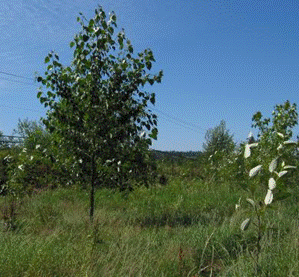 The first tree to have it’s genome sequenced is the western black cottonwood, Populus trichocarpa. This tree has a natural range that spans from Alaska to southern California, and from the Pacific Coast into interior mountain ranges in British Columbia, Washington and Oregon. As a first step towards analyzing genetic variation in this species, a live reference collection of P. trichocarpa has been established at the University of British Columbia (UBC) that includes trees from more than 140 different populations (see map).
The first tree to have it’s genome sequenced is the western black cottonwood, Populus trichocarpa. This tree has a natural range that spans from Alaska to southern California, and from the Pacific Coast into interior mountain ranges in British Columbia, Washington and Oregon. As a first step towards analyzing genetic variation in this species, a live reference collection of P. trichocarpa has been established at the University of British Columbia (UBC) that includes trees from more than 140 different populations (see map).
We have used Ecotilling for the first time as a SNP discovery tool in a species that is long-lived, dioecious and genetically heterogeneous. SNP variation was examined at nine different loci in individuals from 41 different populations distributed throughout most of the P. trichocarpa range. Variation was analyzed both within a single tree (heterozygosity) as well as between individual trees and a reference, P. trichocarpa 383-2499 (Nisqually-1), whose genome has been sequenced. The availability of a sequenced genome made it possible to direct our attention to candidate genes of interest, providing an unprecedented view of genetic variation at multiple loci in this species. This pilot study shows that the level of nucleotide diversity in P. trichocarpa makes it theoretically possible to examine regions of 1000 to 1500 base pairs (bp) in 96 individuals or more on a single gel.
Link to publications arising from this project: ![]()
This project was a collaboration with Quentin Cronk (Centre for Plant Research and Botanical Garden, UBC) and the Genome BC Forestry Genomics project.

